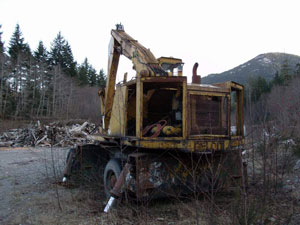


One of our more forgettable log loaders in this DICO. It's not that it is a turkey either. It's just time to forget about it. When we bought it, it was our 'big loader', but that has been a while, actually quite a long while. It came to use from a major timber company salvage yard. Reliability is not really an issue. This 1960's vintage machine has been around here for 20 years more or less and other than replace a dipper cylinder and a few hydraulic lines it has required virtually no maintenance, or should I say we simply haven't done any. Powered by a Detroit Diesel 4-53 it is very economical on fuel compared to the DROTT 80's and American 35's featured elsewhere on these pages which have 2 or 3 times more power. Too old, too small, and too slow, it is about to get parked. (The more recent photos on the right show it heading to the scrap yard.)
It does have a few better ideas in that it was specifically designed as a log loader. It is not a converted excavator. Note the extra joint in the boom. The result of this is that the boom can be extended almost straight out. This is a good thing for loading logs because you can adjust the placement on the truck with a single function.
This loader is on a maximount and sits on 4 pilote truck tires. It is driven by a mechanical drive shaft down through the center bearing. Besides the drive shaft there are notably few controls that have to go through the circle. The brake controls (air) and the steering come to mind as well as the stabilizer controls. This mechanical center drive shaft is the traditional weak spot in a machine of this type. It has to be a hollow vertical shaft (to accommodate air and hydraulic circuits passing the circle) with bevel gears on each end. These are all things waiting to break and they do. If they were always treated nicely, it wouldn't be a problem, but log loader tend to get parked beside the road (so the truck can be in the road) which means they are mired in the mud and the tendency of the operator to rare and snort trying to get back on the road takes its toll.
In their day there were quite a few of these machines around, but alas, that day is gone. Logging machinery that was specifically designed for logging use is less common than it used to be. This used to be sort of the norm, but excavators have become so common that these days it makes more sense to modify a standard excavator into a log loader in most cases than it does to invent one from the ground up. The modifications required are usually fairly minor. Generally the modifications are simply a different boom and a few additional hydraulic circuits for the additional functions required for a log loader.
The photos leave something to be desired in showing how the outriggers work, but they are very interesting. They 'flop out' from the elevated position under the control of a very small hydraulic cylinder and then latch in position with a mechanical latch. Then a very large 'jack' cylinder takes over and jacks the machine up. This compound action using sequential hydraulics contrasts to the single action outriggers on the Drott 80's which are a single arm on a long stroke cylinder. One of their advantages is that they require very little oil or pump capacity to operate. The first cylinder only has to be large enough to lift the jack and the jack itself has no adverse leverage and needs to travel only a short distance to accomplish its mission. A similar 'flop down jack' is used on the Washington TL-6 featured elsewhere in this machinery section.
The elevated cab was imaginatively created to raise and lower for transport. It has a series of cables and pulleys that control it and can be winched up and down using a ratchet wrench as a hand crank. The seat and controls don't lower. The cab just telescopes down over them Elevated cabs are absolute necessities for a log loader as they put the operator up where he can see, but they always result in the machine being over height when loaded on a lowboy for transport.
It's often easier to get good photos of a machine as it is on its way to the scrap yard, and that is the case with the photo sequence on the right. They do provide significant insight as to how the machine was built.